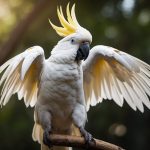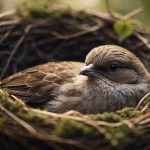What to Do If Your Lovebird Is Sick: Caring Tips for Your Feathered Friend

Lovebirds, with their vibrant feathers and melodious chirps, often become cherished members of our families. As a lovebird owner, I need to recognize when my feathered friend is not feeling well. Usually, lovebirds are hardy, but like any pet, they can fall ill.
Observing any change in behavior or appearance is the first step to addressing their health. I keep an eye out for telltale signs such as lethargy, ruffled feathers, and changes in eating or drinking habits.

Ensuring my lovebird has a comfortable and clean living environment is integral to its health. I make it a priority to maintain the cage regularly and provide a balanced diet rich in nutrients, which are vital for my lovebird’s wellbeing.
However, despite the best preventative care, my lovebird can still develop health issues. I understand common ailments and their treatments, enabling quick action when the need arises. When symptoms persist or are of concern, I know it’s important to consult an avian veterinarian who can offer specialized care and advice for my pet.
Key Points
- Observing behavioral changes in lovebirds can be a sign of sickness.
- A clean habitat and a nutritious diet are key to preventing illness.
- Consult an avian vet if health issues arise or for regular check-ups.
Recognizing Signs of Sickness
When I care for lovebirds, it’s crucial to keep a close eye on their health. Early detection of illness can help ensure prompt treatment and a better chance of recovery. Here are signs and symptoms that may indicate my lovebird is sick:
- Lethargy: If I notice my lovebird is less active or responsive than usual, it could be a sign of illness.
- Loss of Appetite: A decreased interest in food or a sudden weight loss is concerning.
Feathers and Appearance:
- Ruffled or Puffed Up Feathers: Lovebirds often fluff up their feathers to keep warm, but if they’re constantly puffed up, it could indicate discomfort.
- Discharge: Any unusual discharge from the eyes, nostrils, or beak needs attention.
Respiratory Symptoms:
- Difficulty Breathing or Wheezing: Respiratory issues may present as labored breathing or noises when my lovebird breathes.
- Tail Bobbing: If the tail moves up and down with each breath, this is a sign of respiratory distress.
Gastrointestinal Symptoms:
- Vomiting: If my lovebird is regurgitating food frequently or appears to be vomiting, it’s essential to seek veterinary care.
Neurological Symptoms:
- Seizures: Any form of convulsion or seizure is a serious symptom and requires immediate veterinary attention.
Physical Changes:
- Swelling: Swelling of any part of the body, particularly the eyes or abdomen, should not be overlooked.
If my lovebird exhibits any of these symptoms, I make sure to contact an avian veterinarian promptly. Keeping a close bond with my pet helps me notice subtle changes that might indicate illness.
Creating a Healthy Living Environment
To ensure our lovebirds thrive, I focus on specifics like cage size, engaging toys, proper perches, rigorous cleaning routines, and ideal temperature and lighting conditions.
Housing and Space
Space: Lovebirds need ample space to spread their wings and exercise. I ensure their cage is at least 24 inches wide, 24 inches deep, and 24 inches tall. This gives them enough room to move freely and remain active.
Cage Location: Strategically placing the cage in a well-ventilated spot, away from direct sunlight and drafts, is crucial for their comfort.
Toys and Activities
Toys: Providing a variety of toys helps keep my lovebird mentally stimulated and prevents boredom. I include:
- Foraging toys, to simulate natural feeding behaviors.
- Mirrors and bells, for sensory engagement.
- Chewable toys, like those made of safe woods or cardboard, to help maintain their beak health.
I regularly rotate these toys to maintain novelty and interest.
Proper Perch Selection
Perch Variety: It’s important to have a mix of perch sizes and materials to exercise my lovebird’s feet and prevent sores. I use:
- Natural wood perches: for a comfortable grip.
- Rope perches: they offer flexibility and a different texture.
- Calcium or mineral perches: these can provide a source of minerals and aid in beak trimming.
I position the perches at different heights to promote flying and climbing.
Maintaining Cleanliness
Cage Maintenance: Daily cleaning of food and water dishes is a must. Weekly, I remove all toys and perches for a thorough scrub with a bird-safe disinfectant.
Cage Liner: I replace the cage liner—paper or other easily changeable material—daily to monitor my lovebird’s droppings and maintain hygiene.
Temperature and Lighting
Temperature: Keeping the cage in a room where the temperature is consistently between 65°F and 80°F ensures a comfortable environment for my lovebird.
Lighting: I provide natural light sources and avoid placing my lovebird in direct sunlight. If natural light is inadequate, I might use a full-spectrum light to mimic the benefits of natural sunlight and maintain their natural circadian rhythms. An avian heat lamp is useful for sick birds to provide additional warmth.
Diet and Nutrition
When my lovebird is sick, I pay special attention to its diet and nutrition, as they play a critical role in recovery. Ensuring a well-balanced diet rich in vitamins and minerals is essential, alongside constant access to fresh water. https://www.youtube.com/embed/WaOpd7WxWds
Importance of a Balanced Diet
I always make sure my lovebird has a balanced diet which is vital for maintaining its health, especially when it’s ill. This diet should include a variety of foods to provide a broad spectrum of nutrients. Seeds alone are not enough; they can lead to nutritional deficiencies. Instead, I focus on a diet that includes:
- Pellets: These are formulated to provide a complete nutritional package.
- Vegetables: Leafy greens and other veggies are great for vitamins and minerals.
- Fruits: Offered in moderation, fruits can be a source of vitamins. However, I am careful with sugary fruits as they should be a treat, not a staple.
- Calcium: Necessary for bone health, I may include cuttlebone or mineral blocks.
Safe and Harmful Foods
Not all foods are safe for lovebirds, so I’m selective with what I feed mine:
Safe Foods:
- Veggies: broccoli, carrots, and peas.
- Fruits: apples and berries.
- Cooked grains: rice or pasta.
Harmful Foods:
- Avocado is toxic to birds.
- Chocolate and caffeine can be harmful.
- Salty or sugary foods are a no-go.
Hydration and Water Dishes
Hydration is as vital to health as food. I ensure my lovebird always has access to fresh, clean water. I clean the water dish daily to prevent the growth of bacteria and replace the water at least twice a day. Water not only supports their kidney function but is also crucial when my lovebird is on medication or recovering from illness.
Common Health Issues and Treatments
Lovebirds are generally resilient pets, but like all animals, they can fall ill. Recognizing the symptoms of common health issues and seeking treatment early is vital for their well-being. Here’s what I’ve learned about common lovebird diseases and their respective treatments.
Respiratory Infections
Respiratory infections in lovebirds can be serious and often present symptoms such as labored breathing, tail bobbing, and nasal discharge. These issues might be caused by bacterial, fungal, or viral infections, and the treatment typically involves a course of antibiotics. However, it’s crucial to have an avian vet diagnose the exact cause since each type requires different medication.
Psittacosis
Also known as parrot fever, Psittacosis is a contagious disease caused by the bacteria Chlamydophila psittaci. Symptoms include eye infections, diarrhea, and respiratory problems. Treatment requires veterinary care and often involves administering antibiotics like doxycycline. It’s important to know that this disease is zoonotic, meaning it can be transferred to humans, so careful handling and hygiene are paramount.
Pox
Avian pox is a viral disease that manifests in skin lesions primarily on the face, wings, and legs of lovebirds. There’s no direct treatment for the pox virus itself, but secondary bacterial infections can be treated with antibiotics. To prevent the spread, infected birds should be isolated, and I ensure their environment is kept hygienic.
Chlamydiosis
Chlamydiosis is caused by Chlamydia psittaci. It presents with liver problems, lethargy, and respiratory issues. Veterinary intervention is necessary. The typical treatment includes tetracycline antibiotics. Since it’s a contagious disease, all birds in contact should be treated. It’s crucial to maintain strict sanitation procedures.
Psittacine Beak and Feather Disease
This viral disease impacts the bird’s feathers and beak. It leads to feather loss and deformities in the beak. Sadly, there’s currently no cure for Psittacine Beak and Feather Disease. However, careful management of stress and secondary infections is imperative. Veterinary care with a focus on supportive treatment can help manage the disease’s progression.
When to See an Avian Veterinarian

Knowing when to seek professional care for my lovebird is crucial for its health. Early detection and treatment of issues can significantly improve outcomes for my feathered friend.
Scheduling Regular Check-Ups
I understand the importance of regular veterinary check-ups to ensure the well-being of my lovebird. These are not just for vaccinations, but also for:
- Early Diagnosis: Catching potential health issues before they become serious.
- Diet and Nutrition Advice: To keep my bird in top condition.
- Behavioral Consultation: To address any changes that could indicate health problems.
I make it a point to visit an avian veterinarian, who specializes in birds, at least once a year.
Emergency Situations Requiring Immediate Attention
In case my lovebird shows signs of distress, I know it’s critical to seek immediate veterinary care. Here are situations when I don’t hesitate to contact an avian vet:
- Significant Behavioral Changes: If my bird’s behavior alters suddenly, like exhibiting lethargy or aggression.
- Physical Distress: Symptoms like fluffed feathers, difficulty breathing, or a hunched posture.
I’m aware that these signs indicate a potentially serious condition that necessitates urgent attention from an avian professional.
Post-Treatment Care and Monitoring
After treatment, my role is to ensure my lovebird has the best chance at recovery. Follow-up care involves:
- Closely Monitoring: Watching for any changes or improvements in condition.
- Medication and Treatment Compliance: Administering prescribed treatments on time.
- Follow-Up Visits: Returning to the vet as advised for reassessment.
I stay vigilant during this period since it’s essential for the recovery of my lovebird.
Frequently Asked Questions
When my lovebird shows signs of illness, I understand that prompt and correct actions are key to helping them recover.
Below are some FAQs that help me identify and manage the health of my sick lovebird.
How can I treat my sick lovebird at home?
If I notice mild symptoms of illness in my lovebird, the first thing I do is ensure they are in a warm and stress-free environment. Minor issues might be addressed with nutritional support, hydration, and rest, but I always prepare to consult an avian veterinarian in case the symptoms persist or worsen.
What are the symptoms of a sick lovebird?
I keep an eye out for any abnormal behavior or physical signs like ruffled feathers, lethargy, loss of appetite, difficulty breathing, or changes in droppings. These symptoms often indicate that my lovebird might not be feeling well.
Can lovebirds transmit diseases to humans?
Some bird diseases can be zoonotic, meaning they can be passed to humans. If I suspect my lovebird is ill, I practice good hygiene and consult both a veterinarian for my bird and a doctor for myself if necessary.
How can I tell if my lovebird is at the end of its life?
Signs that my lovebird may be nearing the end include significant changes in behavior or appetite, difficulty breathing, or decreased responsiveness. I monitor these signs closely and provide compassionate care, seeking veterinary advice for palliative options.
Why might a lovebird experience heavy breathing or shivering?
Heavy breathing or shivering can be signs of stress, discomfort, or respiratory illness. I check the ambient temperature and eliminate stress factors. If symptoms persist, I know it’s essential to seek veterinary care.
What should I do if my lovebird is sleeping excessively?
I note that excessive sleep might suggest my lovebird is not feeling well or could be in pain. I monitor their behavior alongside other symptoms.
I consult with my vet promptly to determine the underlying cause and appropriate treatment.






